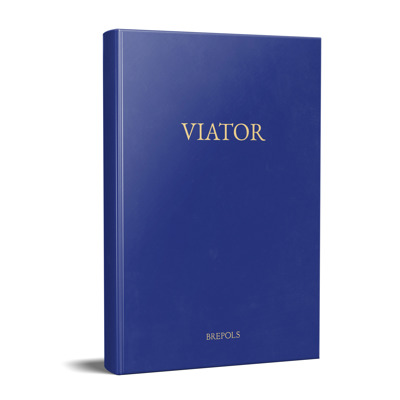
Viator 34 (2003)
- Pages: 406 p.
- Size:175 x 255 mm
- Language(s):English
- Publication Year:2003
- € 63,00 EXCL. VAT RETAIL PRICE
- ISBN: 978-2-503-52243-2
- Hardback
- Out of Print
- E-journal
- Available
Martha Bayless, 'The Story of the Fallen Jew and the Iconography of Jewish Unbelief';
James P. Carley and Myra D. Orth, '"Plus que assez": Simon Bourgouyn and his French Translations from Plutarch, Petrarch, and Lucian';
Lawrence M. Clopper, 'Is the Tretise of Miraclis Pleyinge a Lollard Tract against Devotional Drama?';
Alan B. Cobban, 'Polydore Vergil Reconsidered: The Anglia Historia and the English Universities';
David Cressy, 'God's Time, Rome's Time, and the Calendar of the English Protestant Regime';
Mary A. Edsall, '"True Anchoresses Are Called Birds": Asceticism as Ascent and the Purgative Mysticism of the Ancrene Wisse';
John Eldevik, 'Ecclesiastical Lordship and the Politics of Submitting Tithes in Medieval Germany: The Thuringian Dispute in Social Context';
Alan J. Forey, 'The Charitable Activites of the Templars';
Fiona J. Griffiths, 'Brides and Dominae: Abelard's Cura monialium at the Augustinian Monastery of Marbach';
Maryanne Cline Horowitz, 'Humanist Horticulture: Twelve Agricultural Months and Twelve Categories of Books in Piero de' Medici's Studiolo';
Chris Jones, '"... mais tot por le servise Deu"? Philippe III le Hardi, Charles d'Anjou, and the 1273/74 Imperial Candidature';
John S. Langdon, 'Twilight of the Byzantine Lascarid Basileia in Anatolian Exile, 1254-1258: Continuity and Change in Imperial Geopolitical Strategy';
Jean-Yves Sarazin, 'Marginality and Justice in 1500: The Theft of Sacred Objects in Châlons en Champagne';
Alfred K. Siewers, 'Landscapes of Conversion: Guthlac's Mound and Grendel's Mere as Expressions of Anglo-Saxon Nation-Building';
Brett E. Whalen, 'Joachim of Fiore and the Division of Christendom'.


